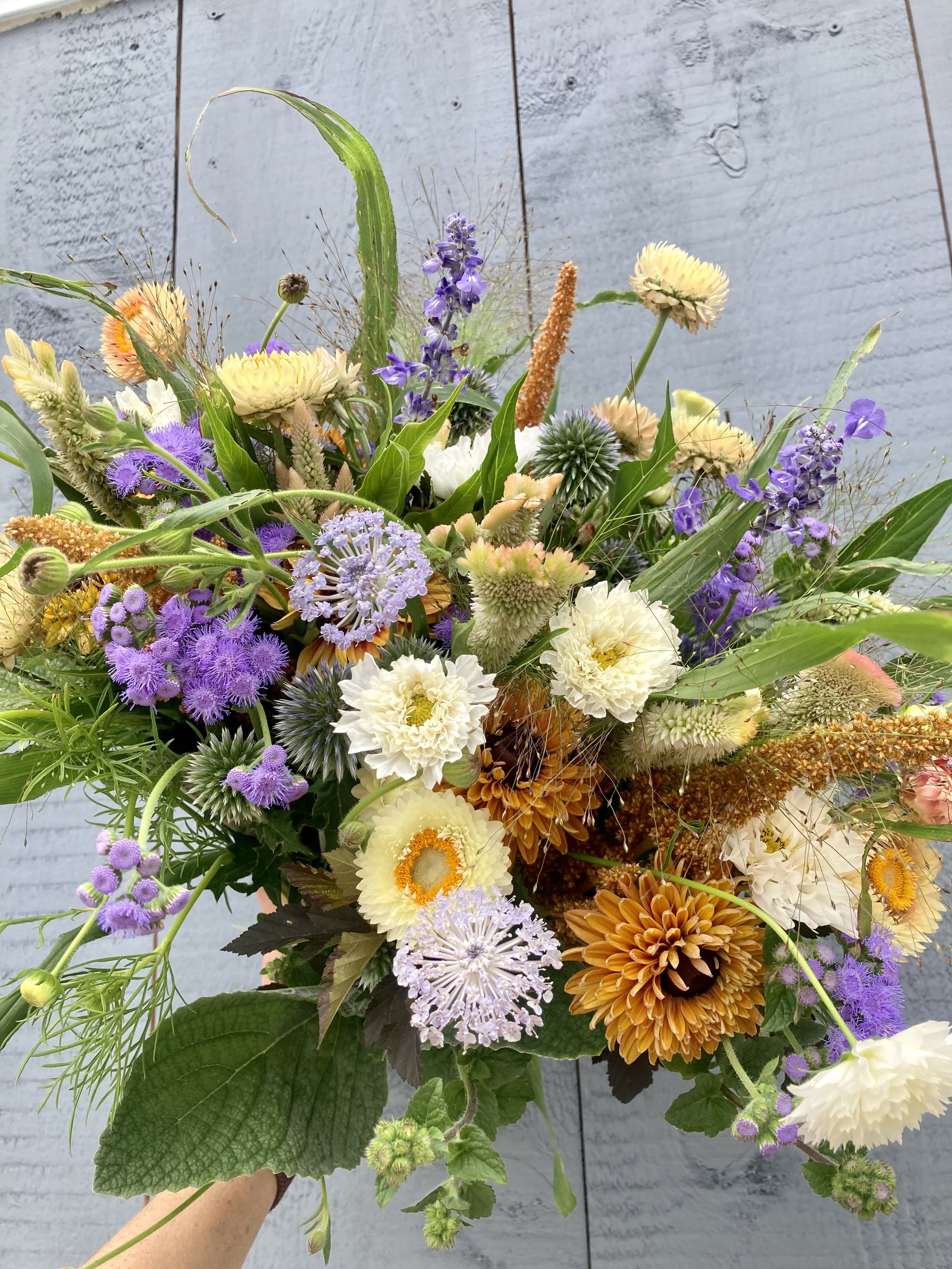Growing your Cutting Garden
Greetings, farm friends!
As we make our way through February, I’ve been dreaming of flowers and warm days spent harvesting and making bouquets. February always feels like the most difficult month to get through; the promise of Spring is so close but the days are still so short and often gloomy. As my mind wanders, dancing through imaginary fields flush with extravagant blooms, I find myself thinking about what I would grow in my own cutting garden if I didn’t have a farm to manage. Growing a cutting garden takes a bit of hard work, but it’s a delightful and rewarding way to bring beauty into your home and garden.
To cut from your garden all season long, you’ll need to plan to have flowers in bloom from spring through fall. Spring flowers are fleeting, and once the warm days hit you’ll quickly bid them adieu and say hello to your summer blooms. Summer blooms tend to last a bit longer in the garden.
Given the proper attention, it’s possible to cut from the same patch of summer blooms all the way up to frost! That said, if you have ample space and want to ensure a quality harvest, it’s best to succession plant, or plant the same flowers several weeks apart to stagger bloom time. In a small garden, this may be difficult, so we recommend that no matter what flowers you plant you should deadhead regularly, and research whether it is possible to cut back your plantings for a high-quality second flush later in the season. It’s also important to take into account the fact that some flowers produce multiple stems, while others will only give you a single cut.
Planning for a cutting garden means you’ll want to take into account all of the elements that make a beautiful floral arrangement. Floral designers tend to break these elements down into the categories of focal flowers, filler, line flowers, and foliage. For a balanced cutting garden, consider growing 1/3 focal flowers, 1/3 filler and line flowers, and 1/3 foliage.
These are some of our favorite, easy to grow flowers to grow in a cutting garden. For those just getting started, summer annuals tend to be the simplest flowers to grow, and they’re widely available to purchase as seedlings or start from seed on your own.
Focal flowers: The main event, these are the big blooms that capture your attention and make an arrangement stand out.
Spring: tulips, daffodils, peonies, rudbeckia hirta, ranunculus
Summer: marigolds, zinnias, sunflowers
Fall: mums, dahlias, ornamental cabbage
Filler flowers: Smaller flowers that complement the focal flowers and make up the majority of an arrangement. A mix of airy blooms and more substantial, disc-shaped flowers.
Spring: ammi, yarrow, bachelors button, sweet peas
Summer: ageratum, echinops, celosia, cosmos
Fall: sorghum, scabiosa, gomphrena
Line/Spike Flowers: Sometimes grouped in with filler flowers, lines and spikes are a critical component of an arrangement. These blooms are tall and determine the height and shape of your design.
Spring: snapdragons, larkspur, delphinium
Summer: salvia, gladiolus, nicotiana
Fall: caryopteris, amaranth
Foliage: The foundation upon which we build almost all of our designs, foliage provides structure and allows the blooms to pop.
We love using woody perennials like ninebark, hydrangea, and currants as foliage- all of which have a long harvest window and make beautiful landscape plants!
Raspberry and blackberry are excellent foliage for summer and fall.
We’re huge fans of eucalyptus and scented geranium as fragrant foliages.
Many Spring flowers are best planted in the fall or late winter for a Spring harvest. Bulbs, such as tulips and daffodils, should be planted in the fall. Bachelors buttons, larkspur, and snapdragons can all be planted in late winter (we plant a succession during the first week of March), for a late Spring harvest, but are also considered “hardy annuals,” meaning they can be planted in the winter, given some protection from the cold, and harvested in Spring before your other flowers are ready! Most summer flowers can be seeded in a tray in April for May planting, or direct seeded as soon as danger of frost has past. For September harvests, consider seeding things like zinnias, cosmos, and marigolds in mid-late June or early July. Perennials have varied planting times and may not always flower in their first season.
Once you’ve decided what you want to grow in your cutting garden, you’ll need to figure out your garden layout. Your garden area should have plenty of sun (full sun is considered at least 6 hours of direct sunlight a day) and access to water. We plant most annuals at a spacing between 6-12 inches; you’ll find spacing recommendations on the backs of seed packets or on seed company websites. Perennials often need more space, as they’ll spread out over their years in the ground. Make sure that you’re giving yourself pathways to move through the garden as your plants mature.
If you haven’t already tested the soil in your garden, it’s absolutely worth doing. In addition to telling you about your soil’s nutrient holding capacity, a comprehensive test can provide information about heavy metals in the soil. For home gardeners, we recommend University of Delaware’s home and garden soil test with lead. Upon receiving your soil test results, you’ll know more about what your soil needs to grow healthy plants. In general, we recommend a balanced organic fertilizer and good compost (for those in Maryland, Veteran’s Compost is a great resource).
The work isn’t over once your garden is planted, but watching your plants grow and bloom is a delightful reward. Many cut flowers benefit from pinching to produce more stems, and you’ll need to weed and water regularly. Once your flowers begin to bloom, you can research the proper stage for cutting and begin your harvest. For harvesting you’ll want to have clean, sharp snips and a bucket of cool water. If possible, it’s best to harvest early in the morning, before the sun hits your garden. Once harvested, allow your blooms to hydrate in a cool place before designing with them.
A good cutting garden has a little bit of everything!
Our seedling sale continues, and we have an abundance of gorgeous flower seedlings available for your cutting gardens.
As always, we have multiple pickup locations in Baltimore, DC, and Carroll County. This year we have an order minimum of $24. For folks who pick up on the farm, we’re offering a 10% discount for on-farm pickup, use the code 2BOOTSPICKUP at checkout.
Find additional details about the Plant Sale on our website.
The seedlings we grow for our annual plant sale are all varieties we’ve grown ourselves and know to perform well in this region. Everything is grown in our greenhouse using organic methods. We take great pride and joy in sending healthy plants into the world, and do our best to maintain quality and grow vigorous seedlings.
If you’d rather choose your plants in person, worry not! We’ll be back at the JFX Market and Flower Mart this year, just in time for you to plant your gardens.
Thanks for reading, and happy garden planning!
Amelia & the rest of the Two Boots Crew
Another plus of growing a cutting garden? Lots of butterfly visitors!




